Spatiotemporal Evolution and Driving Forces of Carbon Decoupling in Tourism in the Yangtze River Economic Belt
Abstract
1. Introduction
2. Literature Review
3. Materials and Methods
3.1. Research Area
3.2. Data Sources
3.3. Influencing Factor Indicators
4. Methodology
4.1. Carbon Emission Estimation Model of Tourism
4.2. The Tapio Decoupling Model
4.3. Spatial Autocorrelation Analysis
4.4. Theil Index Analysis Method
4.5. Geographically Weighted Regression Model
5. Results
5.1. Tourism-Related Carbon Emissions
5.1.1. General Characteristics
5.1.2. Spatial Correlation
5.1.3. Regional Differences
5.2. Temporal and Spatial Evolution of Decoupling Status
5.3. Driving Factors of Decoupling Tourism Carbon
5.3.1. Cross-Sectional Heterogeneity Analysis
5.3.2. Provincial Spatial-Temporal Heterogeneity Analysis
- (i)
- Spatial-Temporal Heterogeneity of Industrial Structure Impact
- (ii)
- Spatial-Temporal Heterogeneity of Urbanization Level Impact
- (iii)
- Spatial-Temporal Heterogeneity of Regional Economic Strength Impact
- (iv)
- Spatial-Temporal Heterogeneity of Technological Innovation Capability Impact
6. Discussion
6.1. Theoretical Contributions
6.2. Policy Implications
6.3. Limitations and Future Directions
7. Conclusions
Author Contributions
Funding
Institutional Review Board Statement
Informed Consent Statement
Data Availability Statement
Acknowledgments
Conflicts of Interest
Appendix A
| Type | Decoupling Status | Degree of Decoupling | Meaning of Indicators |
|---|---|---|---|
| Decoupling | > 0, < 0, < 0 | Strong Decoupling | Tourism revenue has increased while tourism carbon emissions have decreased. |
| > 0, > 0, 0 < < 0.8 | Weak Decoupling | Tourism revenue has increased, and tourism carbon emissions have also risen, but the growth rate of tourism revenue is higher than that of carbon emissions. | |
| < 0, < 0, > 1.2 | Recessive Decoupling | Tourism revenue has decreased, and tourism carbon emissions have also declined, but the rate of decline in tourism revenue is lower than that of carbon emissions. | |
| Coupling | < 0, < 0, 0.8 < < 1.2 | Recessive Coupling | Tourism revenue has decreased, and tourism carbon emissions have also declined, but the rates of decline for both are essentially the same. |
| > 0, > 0, 0.8 < < 1.2 | Expansive Coupling | Tourism revenue has increased, and tourism carbon emissions have also risen, but the rates of growth for both are essentially the same. | |
| Negative Decoupling | > 0, > 0, > 1.2 | Expansive Negative Decoupling | Tourism revenue has increased, and tourism carbon emissions have also risen, but the rate of increase in carbon emissions is greater than that of tourism revenue. |
| < 0, < 0, 0 < < 0.8 | Weak Negative Decoupling | Tourism revenue has decreased, and tourism carbon emissions have also declined, but the rate of decline in tourism revenue is greater than that of carbon emissions. | |
| < 0, > 0, < 0 | Strong Negative Decoupling | Tourism revenue has decreased, and tourism carbon emissions have also declined, but the rate of decline in tourism revenue is greater than that of carbon emissions. |
Appendix B
| Year | Tourism Transport | Tourism Activities | Tourism Accommodation | Total Carbon Emissions of the Tourism Industry | Total Carbon Emissions of the YREB | Percentage of Carbon Emissions from the Tourism Industry |
|---|---|---|---|---|---|---|
| 2009 | 3433.80 | 102.38 | 151.47 | 3687.65 | 321,928.08 | 1.15 |
| 2010 | 3852.99 | 155.08 | 130.35 | 4138.42 | 348,731.77 | 1.19 |
| 2011 | 4342.83 | 221.26 | 130.28 | 4694.37 | 380,425.49 | 1.23 |
| 2012 | 5055.26 | 269.04 | 139.83 | 5464.14 | 386,042.90 | 1.42 |
| 2013 | 4794.03 | 308.13 | 129.02 | 5231.18 | 385,608.00 | 1.36 |
| 2014 | 4173.48 | 466.13 | 125.52 | 4765.14 | 381,938.91 | 1.25 |
| 2015 | 4317.11 | 517.36 | 121.51 | 4955.98 | 374,630.53 | 1.32 |
| 2016 | 4397.98 | 477.21 | 115.12 | 4990.30 | 379,343.60 | 1.32 |
| 2017 | 4666.53 | 530.83 | 113.53 | 5310.90 | 385,323.09 | 1.38 |
| 2018 | 4872.35 | 585.88 | 109.83 | 5568.07 | 387,508.19 | 1.44 |
| 2019 | 5130.30 | 649.83 | 99.53 | 5879.66 | 398,381.22 | 1.48 |
| 2020 | 3537.22 | 432.57 | 65.72 | 4035.51 | 440,609.63 | 0.92 |
| 2021 | 4719.77 | 572.95 | 380.07 | 5672.80 | 370,771.24 | 1.53 |
| 2022 | 5440.80 | 717.39 | 190.46 | 6348.66 | 391,892.59 | 1.62 |
References
- Zhu, Y.; Hu, Y.; Zhu, Y. Can China’s energy policies achieve the “dual carbon” goal? A multi-dimensional analysis based on policy text tools. Environ. Dev. Sustain. 2024, 1–40. [Google Scholar] [CrossRef]
- Zhou, M.; Yang, J.; Ning, X.; Wu, C.; Zhang, Y. Analysis of the Characteristics and Driving Mechanisms of Carbon Emission Decoupling in the Hu-Bao-O-Yu City Cluster under the “Double Carbon” Target. Sustainability 2024, 16, 7290. [Google Scholar] [CrossRef]
- Chen, H.; Peng, X.; Wang, Z.; Bo, Y. Research on Decoupling Relationship among Energy Consumption, Carbon Emissions, and Economic Growth under Dual Carbon Goals in China. In Proceedings of the 2023 3rd Power System and Green Energy Conference (PSGEC), Shanghai, China, 24–26 August 2023; IEEE: New York, NY, USA, 2023; pp. 779–784. [Google Scholar]
- Gössling, S. Carbon neutral destinations: A conceptual analysis. J. Sustain. Tour. 2009, 17, 17–37. [Google Scholar] [CrossRef]
- Eika, L.; Mogstad, M.; Vestad, O.L. What can we learn about household consumption expenditure from data on income and assets? J. Public Econ. 2020, 189, 104163. [Google Scholar] [CrossRef]
- Lenzen, M.; Sun, Y.Y.; Faturay, F.; Ting, Y.P.; Geschke, A.; Malik, A. The carbon footprint of global tourism. Nat. Clim. Change 2018, 8, 522–528. [Google Scholar] [CrossRef]
- Reilly, J.; Williams, P.; Haider, W. Moving towards more eco-efficient tourist transportation to a resort destination: The case of Whistler, British Columbia. Res. Transp. Econ. 2010, 26, 66–73. [Google Scholar] [CrossRef]
- Gössling, S.; Peeters, P. Assessing tourism’s global environmental impact 1900–2050. J. Sustain. Tour. 2015, 23, 639–659. [Google Scholar] [CrossRef]
- Zhang, J.; Zhang, Y. Carbon tax, tourism CO2 emissions and economic welfare. Ann. Tour. Res. 2018, 69, 18–30. [Google Scholar] [CrossRef]
- Zha, J.; Dai, J.; Ma, S.; Chen, Y.; Wang, X. How to decouple tourism growth from carbon emissions? A case study of Chengdu, China. Tour. Manag. Perspect. 2021, 39, 100849. [Google Scholar] [CrossRef]
- Tang, Z.; Shang, J.; Shi, C.; Liu, Z.; Bi, K. Decoupling indicators of CO2 emissions from the tourism industry in China: 1990–2012. Ecol. Indic. 2014, 46, 390–397. [Google Scholar] [CrossRef]
- Karakaya, E.; Bostan, A.; Özçağ, M. Decomposition and decoupling analysis of energy-related carbon emissions in Turkey. Environ. Sci. Pollut. Res. 2019, 26, 32080–32091. [Google Scholar] [CrossRef]
- Climent, F.; Pardo, A. Decoupling factors on the energy–output linkage: The Spanish case. Energy Policy 2007, 35, 522–528. [Google Scholar] [CrossRef]
- Robaina-Alves, M.; Moutinho, V.; Costa, R. Change in energy-related CO2 (carbon dioxide) emissions in Portuguese tourism: A decomposition analysis from 2000 to 2008. J. Clean. Prod. 2016, 111, 520–528. [Google Scholar] [CrossRef]
- Tang, C.; Zhong, L.; Ng, P. Factors that influence the tourism industry’s carbon emissions: A tourism area life cycle model perspective. Energy Policy 2017, 109, 704–718. [Google Scholar] [CrossRef]
- Chen, J.; Zhao, A.; Zhao, Q.; Song, M.; Baležentis, T.; Streimikiene, D. Estimation and factor decomposition of carbon emissions in China’s tourism sector. Probl. Ekorozwoju 2018, 13, 91–101. [Google Scholar]
- Li, L.; Li, J.; Tang, L.; Wang, S. Balancing tourism’s economic benefit and CO2 emissions: An insight from input–output and tourism satellite account analysis. Sustainability 2019, 11, 1052. [Google Scholar] [CrossRef]
- Ma, H.; Liu, J.; Xi, J. Decoupling and decomposition analysis of carbon emissions in Beijing’s tourism traffic. Environ. Dev. Sustain. 2022, 24, 5258–5274. [Google Scholar] [CrossRef]
- Xie, P.; Gao, S.; Sun, F. An analysis of the decoupling relationship between CO2 emission in power industry and GDP in China based on LMDI method. J. Clean. Prod. 2019, 211, 598–606. [Google Scholar] [CrossRef]
- Wu, Y.; Yuan, C.; Liu, Z.; Wu, H.; Wei, X. Decoupling relationship between the non-grain production and intensification of cultivated land in China based on Tapio decoupling model. J. Clean. Prod. 2023, 424, 138800. [Google Scholar] [CrossRef]
- Tang, Z.; Bai, S.; Shi, C.; Liu, L.; Li, X. Tourism-Related CO2 Emission and Its Decoupling Effects in China: A spatiotemporal perspective. Adv. Meteorol. 2018, 2018, 1473184. [Google Scholar] [CrossRef]
- Gan, H.; Zhu, D.; Waqas, M. How to decouple tourism growth from carbon emission? A panel data from China and tourist nations. Heliyon 2024, 10, e35030. [Google Scholar] [CrossRef]
- Meng, W.; Xu, L.; Hu, B.; Zhou, J.; Wang, Z. Quantifying direct and indirect carbon dioxide emissions of the Chinese tourism industry. J. Clean. Prod. 2016, 126, 586–594. [Google Scholar] [CrossRef]
- Guo, L.; Li, P.; Zhang, J.; Xiao, X.; Peng, H. Do socio-economic factors matter? A comprehensive evaluation of tourism eco-efficiency determinants in China based on the Geographical Detector Model. J. Environ. Manag. 2022, 320, 115812. [Google Scholar] [CrossRef]
- Li, D.; Zhang, J. Measurement and analysis of ecological pressure due to industrial development in the Yangtze River economic belt from 2010 to 2018. J. Clean. Prod. 2022, 353, 131614. [Google Scholar] [CrossRef]
- Wang, W.; Li, M.; Zhang, M. Study on the changes of the decoupling indicator between energy-related CO2 emission and GDP in China. Energy 2017, 128, 11–18. [Google Scholar] [CrossRef]
- Huang, H.; Tang, L.X. Calculation analysis of tourism carbon emissions amount—A case study. Chem. Eng. Trans. 2016, 51, 1165–1170. [Google Scholar]
- Tapio, P. Towards a theory of decoupling: Degrees of decoupling in the EU and the case of road traffic in Finland between 1970 and 2001. Transp. Policy 2005, 12, 137–151. [Google Scholar] [CrossRef]
- Westerholt, R. A simulation study to explore inference about global Moran’s I with random spatial indexes. Geogr. Anal. 2023, 55, 621–650. [Google Scholar] [CrossRef]
- Tian, Q.; Zhao, T.; Yuan, R. An overview of the inequality in China’s carbon intensity 1997–2016: A Theil index decomposition analysis. Clean Technol. Environ. Policy 2021, 23, 1581–1601. [Google Scholar] [CrossRef]
- Ausloos, M.; Miśkiewicz, J. Introducing the q-Theil index. Braz. J. Phys. 2009, 39, 388–395. [Google Scholar]
- Wheeler, D.C. Geographically weighted regression. In Handbook of Regional Science; Springer: Berlin/Heidelberg, Germany, 2021; pp. 1895–1921. [Google Scholar]

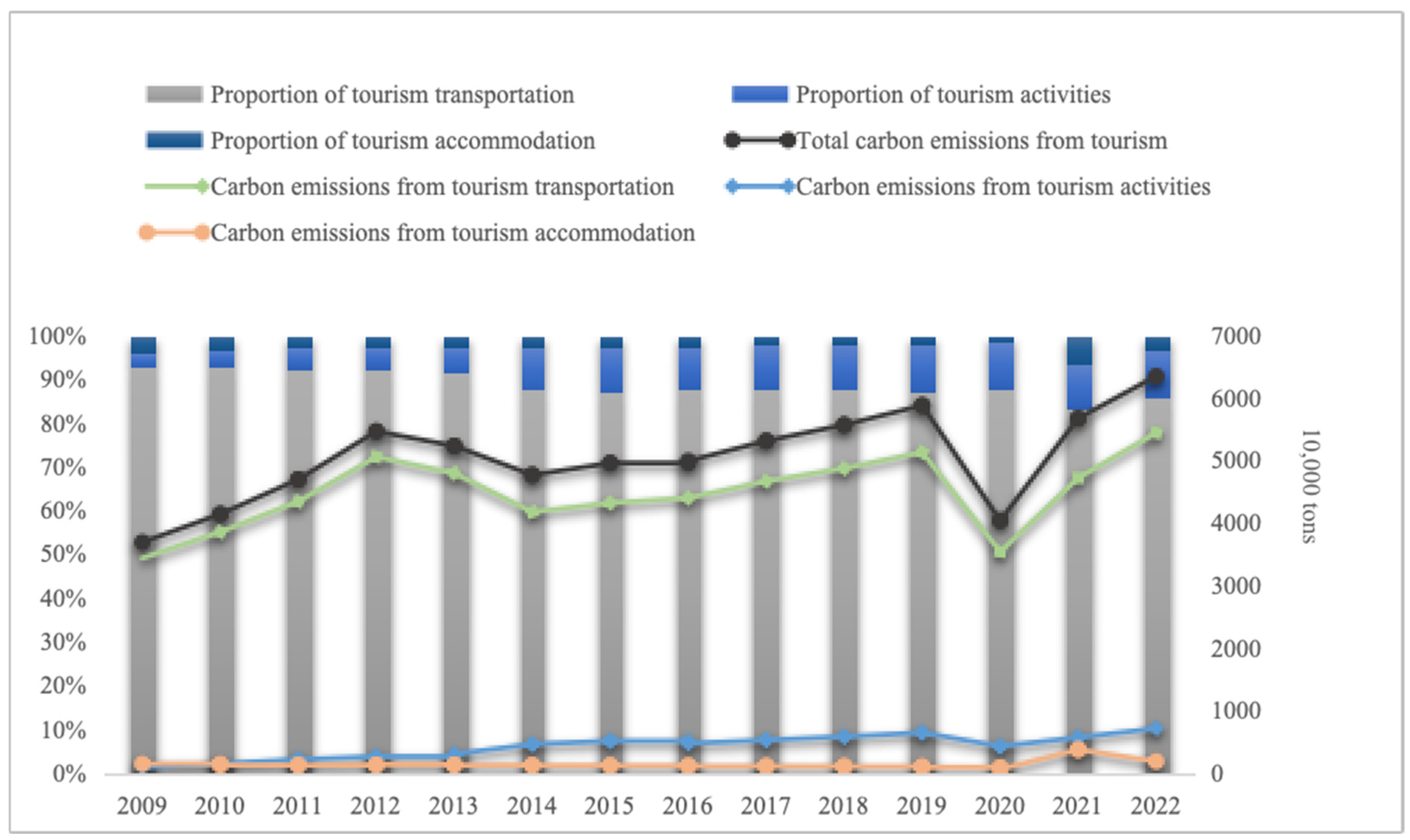
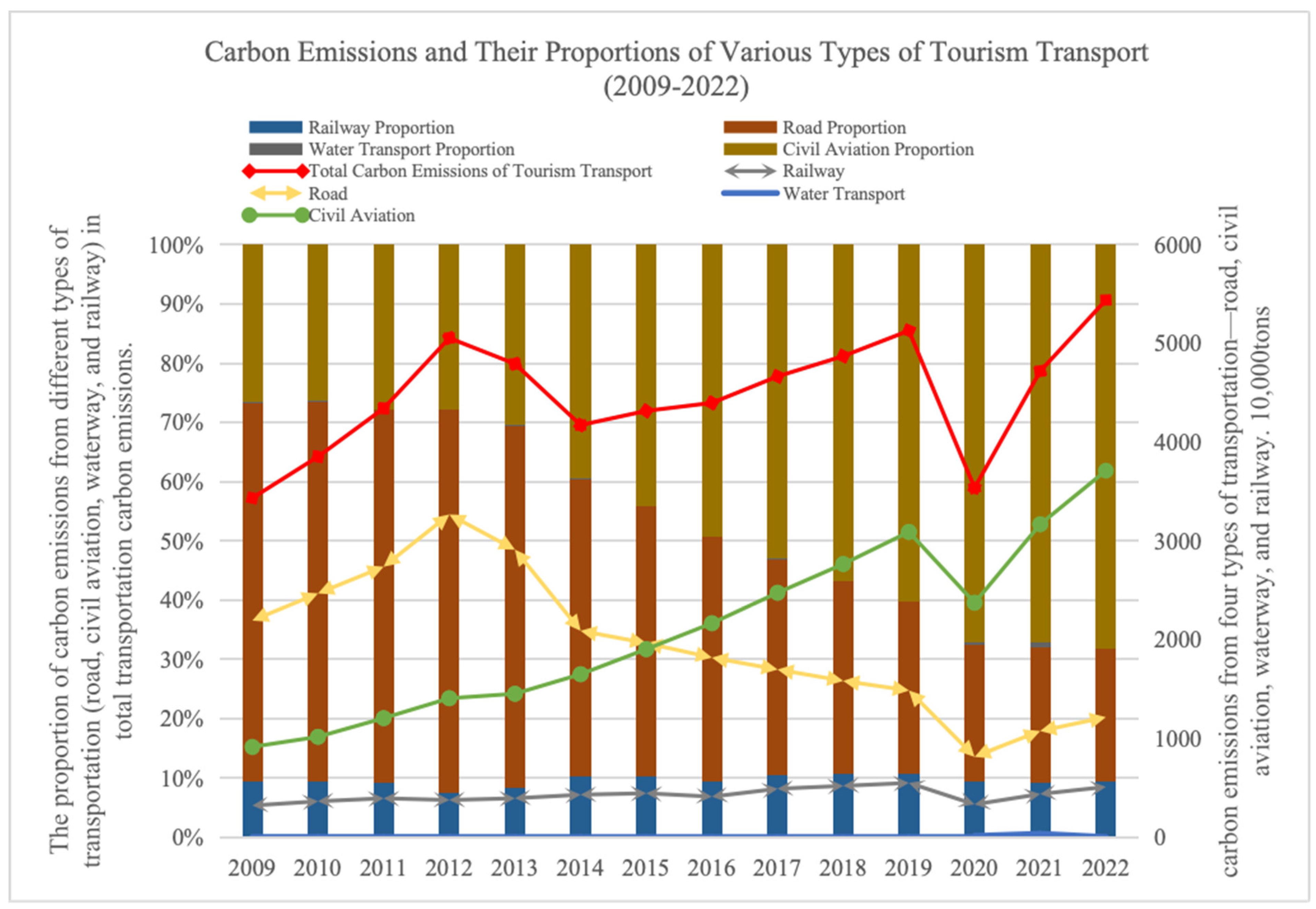
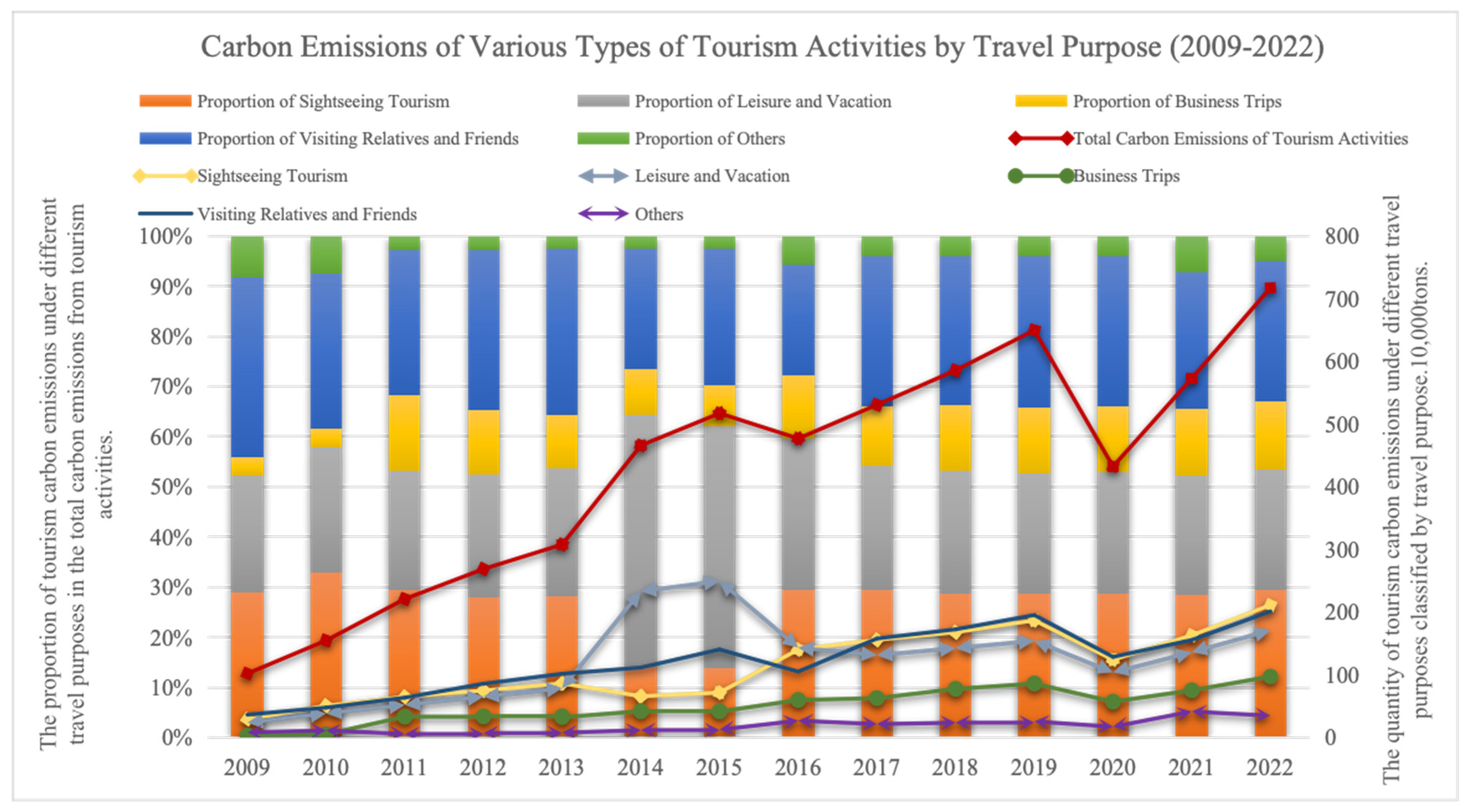

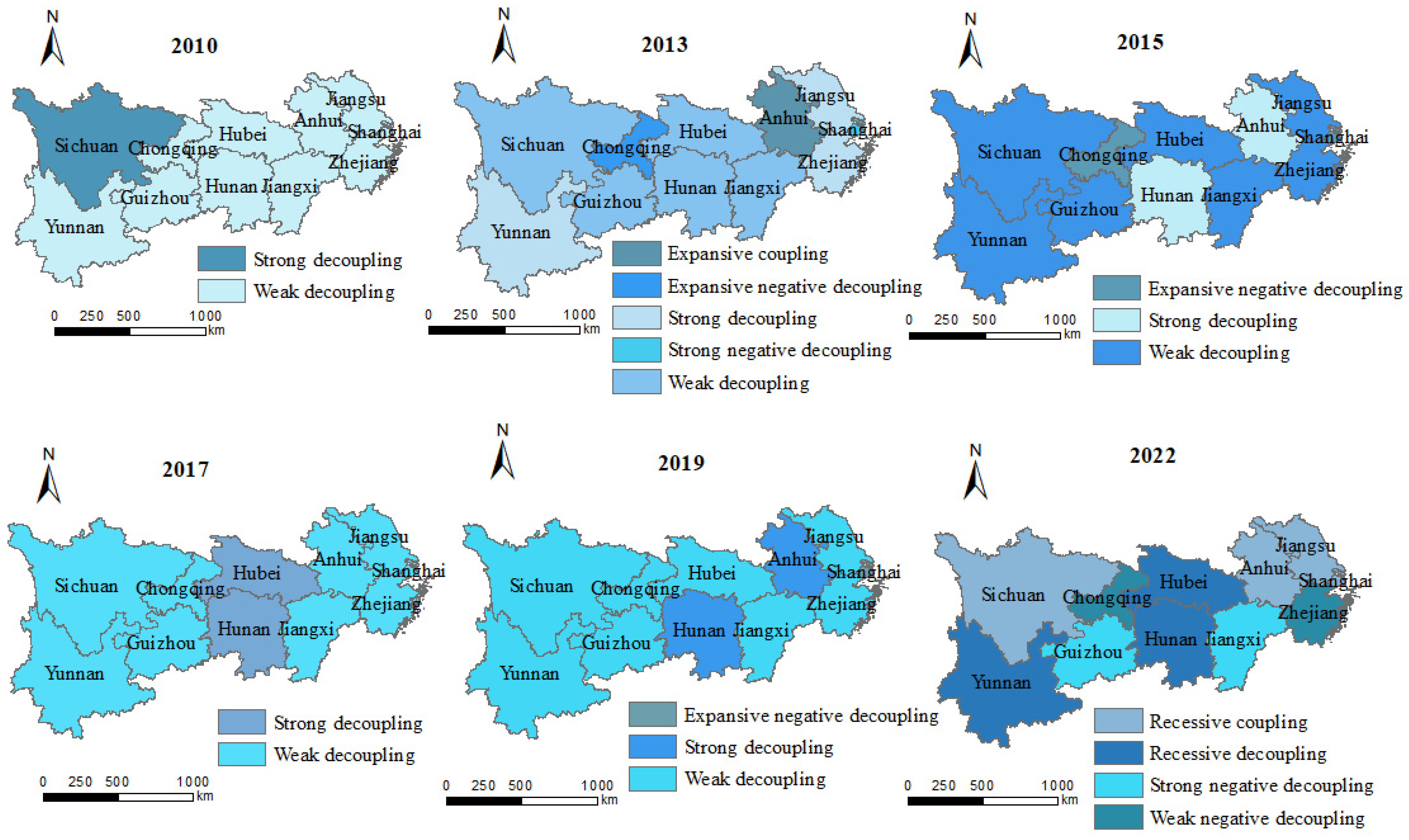
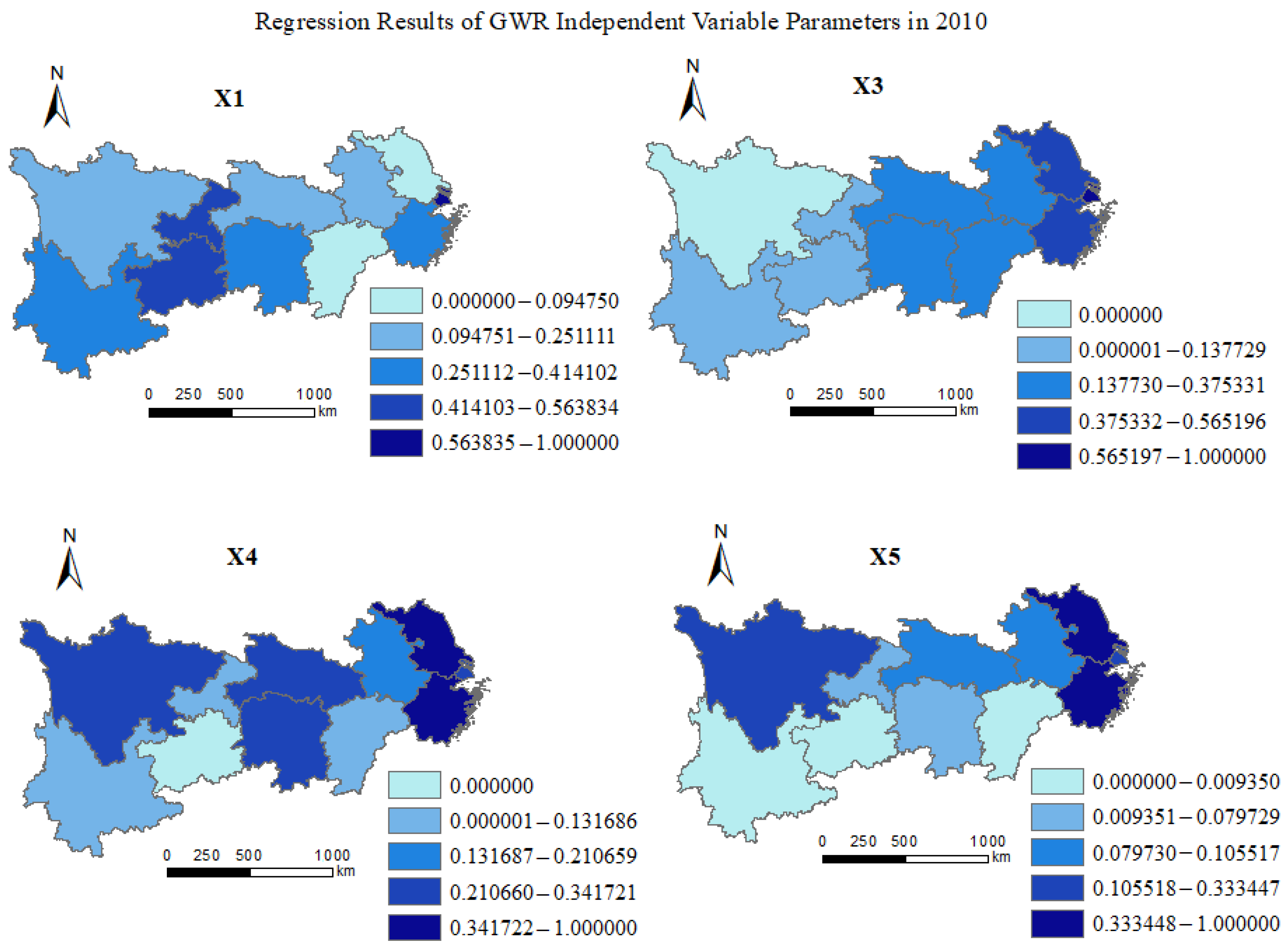

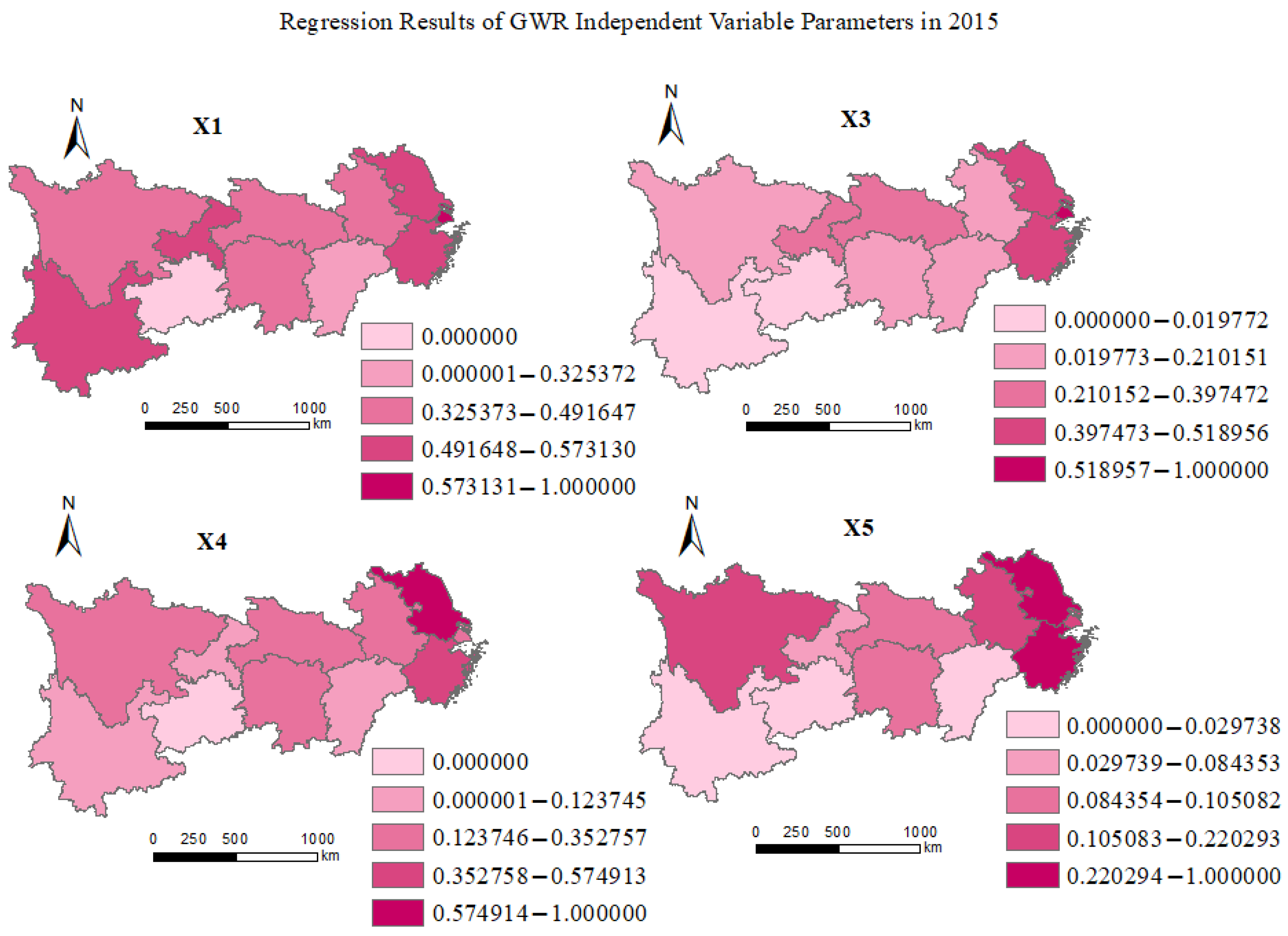

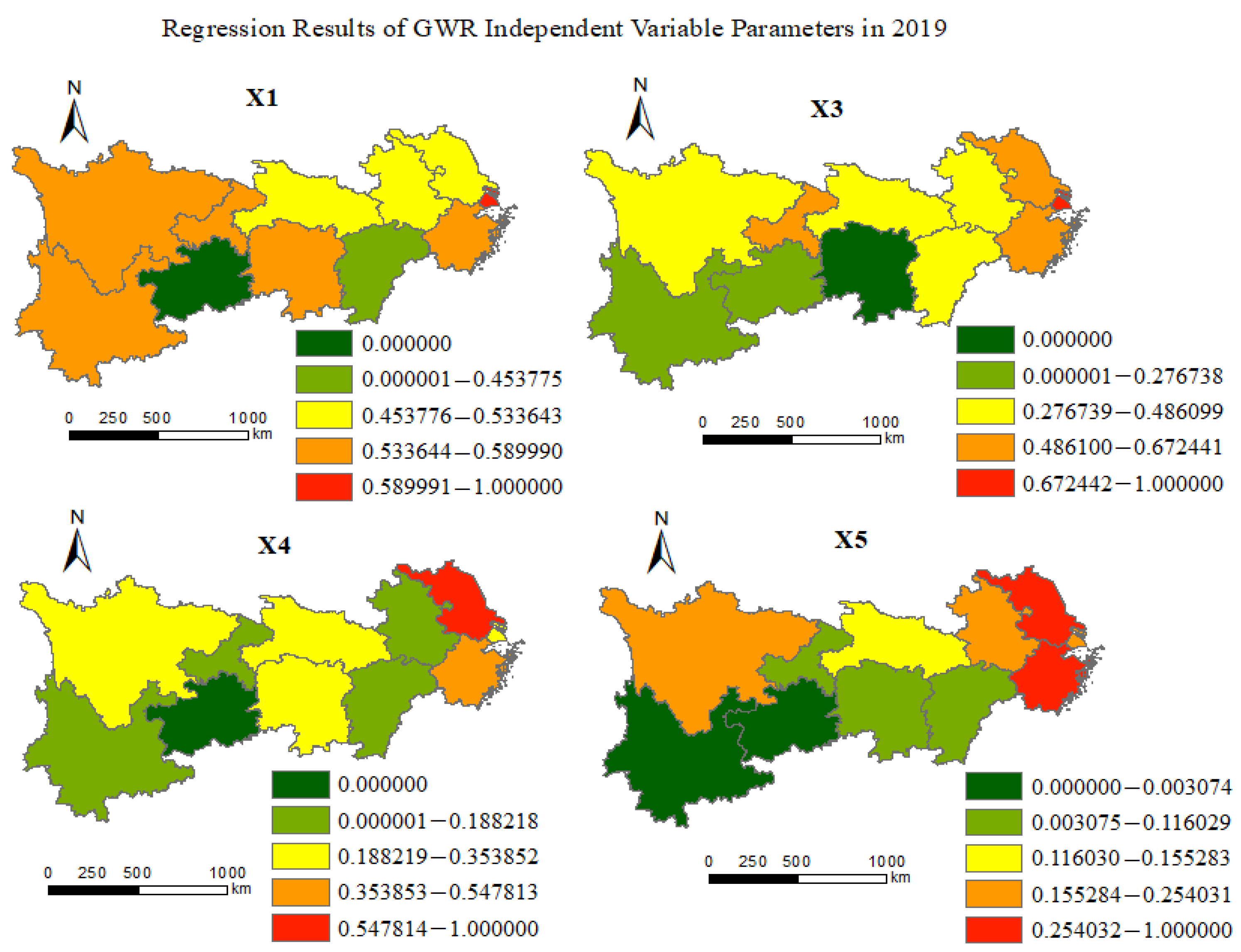
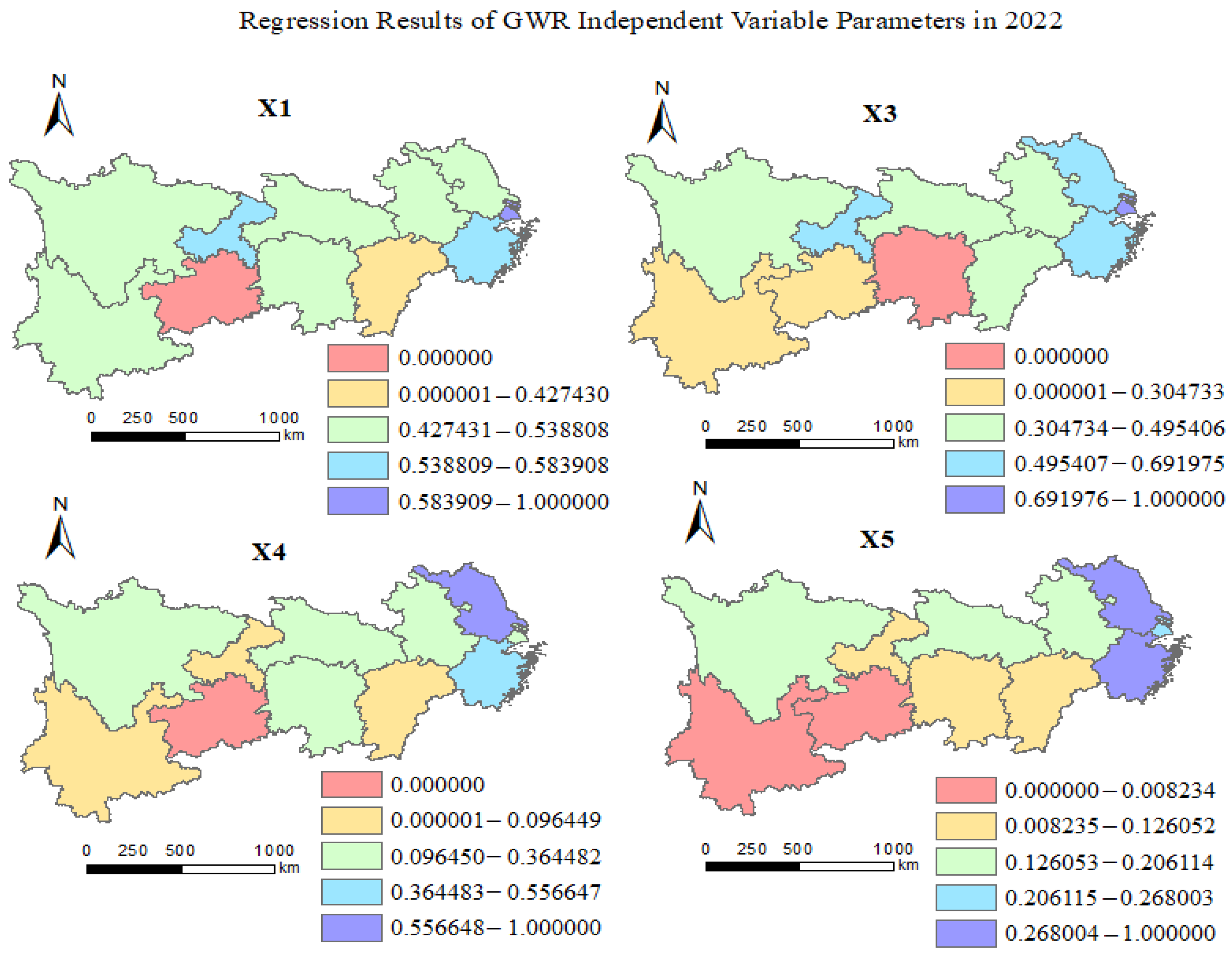
| Detection Factor | Variable Representation | Specific Indicators and Their Meanings | Unit |
|---|---|---|---|
| Industrial Structure (IS) | X1 | The proportion of tertiary industry | % |
| Consumer Spending Power (CSP) | X2 | Per capita disposable income | Yuan |
| Urbanization Index (UI) | X3 | The proportion of the urban population | % |
| Regional GDP (RGDP) | X4 | The total number of domestic and foreign tourists | 100 million |
| Technological Innovation Capability (TIC) | X5 | Patent application authorization | 10,000 pieces |
| Government Policy (GP) | X6 | The government expenditures on energy protection and environmental conservation | 100 million |
| Tourist Arrival (TA) | X7 | The total number of domestic and foreign tourists | 10,000 people |
| Consumption Level (CL) | X8 | The total tourism revenue/tourism arrival | Yuan/person |
| Year | Moran’s I | p-Value | Sd | Z-Value | Mean |
|---|---|---|---|---|---|
| 2009 | −0.0841 | 0.0010 *** | 0.0247 | −4.9208 | −0.0303 |
| 2010 | −0.0307 | 0.0010 *** | 0.0191 | −2.3263 | −0.0307 |
| 2011 | −0.0659 | 0.0060 *** | 0.0073 | 4.6964 | −0.1002 |
| 2012 | −0.0452 | 0.0121 ** | 0.0245 | −2.2835 | −0.0302 |
| 2013 | −0.0302 | 0.0085 *** | 0.0347 | −2.8389 | −0.0308 |
| 2014 | −0.0425 | 0.0032 *** | 0.0085 | −1.9086 | −0.0084 |
| 2015 | −0.0659 | 0.0060 *** | 0.0073 | 4.6964 | −0.1002 |
| 2016 | −0.0644 | 0.0140 ** | 0.0156 | 2.3299 | −0.1007 |
| 2017 | −0.1305 | 0.0670 * | 0.0185 | −1.7150 | −0.0989 |
| 2018 | −0.0803 | 0.0900 * | 0.0150 | 1.3100 | −0.1000 |
| 2019 | −0.0550 | 0.0330 ** | 0.0176 | 2.5629 | −0.1002 |
| 2020 | −0.0390 | 0.0010 *** | 0.0125 | −3.1931 | −0.0302 |
| 2021 | −0.0905 | 0.0550 * | 0.0285 | −1.6150 | −0.0889 |
| 2022 | −0.0421 | 0.0032 *** | 0.0423 | −2.3589 | −0.0288 |
| Year | Within the Region | TWR | Contribution Rate within the Region: % | TBR | Contribution Rate Between Regions: % | Theil | |||||
|---|---|---|---|---|---|---|---|---|---|---|---|
| Western | Central | Eastern | |||||||||
| Difference | Contribution Rate: % | Difference | Contribution Rate: % | Difference | Contribution Rate: % | ||||||
| 2009 | 0.0115 | 21.40 | 0.0184 | 34.21 | 0.0238 | 44.39 | 0.0197 | 31.84 | 0.0421 | 68.16 | 0.0618 |
| 2010 | 0.0033 | 6.80 | 0.0194 | 39.60 | 0.0262 | 53.60 | 0.0192 | 35.92 | 0.0342 | 64.08 | 0.0534 |
| 2011 | 0.0122 | 22.06 | 0.0091 | 16.38 | 0.0343 | 61.56 | 0.0222 | 49.10 | 0.0231 | 50.90 | 0.0453 |
| 2012 | 0.0574 | 65.25 | 0.0089 | 10.09 | 0.0217 | 24.65 | 0.0276 | 46.27 | 0.0320 | 53.73 | 0.0597 |
| 2013 | 0.0182 | 12.99 | 0.0150 | 10.72 | 0.1071 | 76.30 | 0.0557 | 61.88 | 0.0343 | 38.12 | 0.0899 |
| 2014 | 0.0199 | 12.36 | 0.0141 | 8.72 | 0.1276 | 78.92 | 0.0624 | 92.50 | 0.0051 | 7.50 | 0.0674 |
| 2015 | 0.0277 | 12.81 | 0.0114 | 5.25 | 0.1774 | 81.94 | 0.0805 | 98.34 | 0.0014 | 1.66 | 0.0819 |
| 2016 | 0.0458 | 15.80 | 0.0248 | 8.56 | 0.2194 | 75.64 | 0.1016 | 95.96 | 0.0043 | 4.04 | 0.1059 |
| 2017 | 0.0698 | 21.75 | 0.0085 | 2.64 | 0.2426 | 75.60 | 0.1067 | 89.71 | 0.0122 | 10.29 | 0.1189 |
| 2018 | 0.0836 | 23.09 | 0.0086 | 2.38 | 0.2699 | 74.53 | 0.1166 | 84.46 | 0.0214 | 15.54 | 0.1380 |
| 2019 | 0.0965 | 23.88 | 0.0108 | 2.68 | 0.2967 | 73.43 | 0.1259 | 78.88 | 0.0337 | 21.12 | 0.1597 |
| 2020 | 0.2753 | 48.29 | 0.0770 | 13.51 | 0.2179 | 38.21 | 0.1863 | 88.76 | 0.0236 | 11.24 | 0.2099 |
| 2021 | 0.0122 | 22.06 | 0.0091 | 16.38 | 0.0343 | 61.56 | 0.0222 | 49.10 | 0.0231 | 50.90 | 0.0453 |
| 2022 | 0.0172 | 12.88 | 0.0176 | 10.83 | 0.1071 | 76.30 | 0.0557 | 61.88 | 0.0343 | 38.12 | 0.0899 |
| Core Parameter | Maximum Value | Minimum Value | Mean | Median |
|---|---|---|---|---|
| β1 | 3.02 | 0.22 | 1.44 | 0.31 |
| β2 | 1.09 | −3.41 | −1.11 | −1.97 |
| β3 | 3.48 | −8.75 | −2.19 | −0.88 |
| β4 | 6.43 | −2.52 | 1.38 | 0.91 |
| Year | X1 | X3 | X4 | X5 |
|---|---|---|---|---|
| 2010 | −0.22 | 0.69 | −0.89 | 0.36 |
| 2012 | 0.31 | 3.41 | −1.78 | 5.49 |
| 2014 | 0.33 | 3.45 | −1.23 | 4.43 |
| 2016 | 0.13 | 1.09 | 0.51 | −0.91 |
| 2018 | 0.31 | 0.40 | 1.19 | −1.51 |
| 2020 | 1.35 | −0.53 | 2.56 | −1.87 |
| 2022 | 2.41 | −1.97 | 3.78 | −2.52 |
Disclaimer/Publisher’s Note: The statements, opinions and data contained in all publications are solely those of the individual author(s) and contributor(s) and not of MDPI and/or the editor(s). MDPI and/or the editor(s) disclaim responsibility for any injury to people or property resulting from any ideas, methods, instructions or products referred to in the content. |
© 2025 by the authors. Licensee MDPI, Basel, Switzerland. This article is an open access article distributed under the terms and conditions of the Creative Commons Attribution (CC BY) license (https://creativecommons.org/licenses/by/4.0/).
Share and Cite
Tang, Q.; Wang, Q.; Zhang, S. Spatiotemporal Evolution and Driving Forces of Carbon Decoupling in Tourism in the Yangtze River Economic Belt. Sustainability 2025, 17, 7516. https://doi.org/10.3390/su17167516
Tang Q, Wang Q, Zhang S. Spatiotemporal Evolution and Driving Forces of Carbon Decoupling in Tourism in the Yangtze River Economic Belt. Sustainability. 2025; 17(16):7516. https://doi.org/10.3390/su17167516
Chicago/Turabian StyleTang, Qunli, Qi Wang, and Shouhao Zhang. 2025. "Spatiotemporal Evolution and Driving Forces of Carbon Decoupling in Tourism in the Yangtze River Economic Belt" Sustainability 17, no. 16: 7516. https://doi.org/10.3390/su17167516
APA StyleTang, Q., Wang, Q., & Zhang, S. (2025). Spatiotemporal Evolution and Driving Forces of Carbon Decoupling in Tourism in the Yangtze River Economic Belt. Sustainability, 17(16), 7516. https://doi.org/10.3390/su17167516






